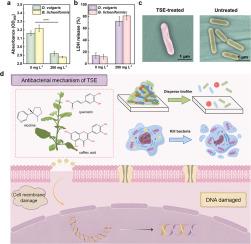具有抗菌和缓蚀特性的双功能环保烟草茎提取物,可减轻微生物影响的腐蚀
IF 14.3
1区 材料科学
Q1 MATERIALS SCIENCE, MULTIDISCIPLINARY
引用次数: 0
摘要
从农业废弃物中提取的烟草茎提取物(TSE)是一种新型的生态友好型双功能抗微生物腐蚀剂。TSE具有广谱抗菌特性,对革兰氏阴性的寻常脱硫弧菌和革兰氏阳性的地衣芽孢杆菌的生物膜具有99.9%的抗菌效果。此外,TSE还能使寻常夜蛾和地衣芽孢杆菌的MIC率分别降低98%和91%。此外,TSE在减轻非生物腐蚀方面的效率为85%。根据分子模拟,发现其抗菌机制源于生物活性成分(尼古丁、槲皮素、咖啡酸)对微生物细胞的破坏,而腐蚀抑制作用源于TSE在金属表面的吸附。这些结果表明,TSE不仅将抗菌和防腐功能整合到单一的天然提取物中,而且还提供了对废物的可持续利用以进行资源回收,为工业MIC缓解提供了传统商业杀菌剂的有前途的绿色替代品。本文章由计算机程序翻译,如有差异,请以英文原文为准。

Bifunctional eco-friendly tobacco stem extract with antibacterial and corrosion inhibition properties for mitigating microbiologically influenced corrosion
Tobacco stem extract (TSE), derived from agricultural waste, was developed as a novel eco-friendly bifunctional agent for mitigating microbiologically influenced corrosion (MIC). TSE exhibited broad-spectrum antibacterial properties, achieving an exceptional efficacy of 99.9% against gram-negative Desulfovibrio vulgaris and gram-positive Bacillus licheniformis sessile cells in their biofilms. TSE also decreased MIC rates by 98% and 91% for D. vulgaris and B. licheniformis, respectively. Additionally, TSE showed an efficiency of 85% in mitigating abiotic corrosion. The antimicrobial mechanism was found to stem from microbial cell disruption by bioactive components (nicotine, quercetin, caffeic acid), while corrosion inhibition arises from TSE adsorption on metal surfaces according to molecular simulation. These results demonstrated that TSE not only integrates antimicrobial and anticorrosion functions into a single natural extract, but also provides a sustainable utilization of waste for resource recovery, offering a promising green alternative to conventional commercial biocides for industrial MIC mitigation.
求助全文
通过发布文献求助,成功后即可免费获取论文全文。
去求助
来源期刊

Journal of Materials Science & Technology
工程技术-材料科学:综合
CiteScore
20.00
自引率
11.00%
发文量
995
审稿时长
13 days
期刊介绍:
Journal of Materials Science & Technology strives to promote global collaboration in the field of materials science and technology. It primarily publishes original research papers, invited review articles, letters, research notes, and summaries of scientific achievements. The journal covers a wide range of materials science and technology topics, including metallic materials, inorganic nonmetallic materials, and composite materials.
 求助内容:
求助内容: 应助结果提醒方式:
应助结果提醒方式:


